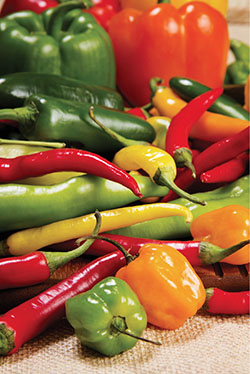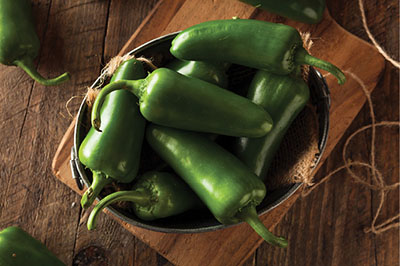Guide H-240
Revised by Stephanie Walker and Paul Bosland
College of Agricultural, Consumer and Environmental Sciences, New Mexico State University
Respectively, Extension Vegetable Specialist, Department of Extension Plant Sciences; and Regents Professor, Department of Plant and Environmental Sciences, New Mexico State University. (Print Friendly PDF)
Chile peppers (Capsicum spp.), including bell peppers, exhibit a wide variety of shapes, sizes, colors, and flavors (Figure 1). The term “pepper” should not be confused with “black pepper” (Piper nigrum), which is produced from the dried, unripe fruit of a vine grown in the tropics. Chile peppers can be classified into two groups: mild- or sweet-tasting fruit (bell, pimento, sweet wax, etc.; Figure 2) and fruit with heat or pungency (New Mexican, jalapeño, serrano, etc.; (Figure 3).
Chile pepper pungency is determined by the amount and types of capsaicinoids found in the fruit. These alkaloids are chemical compounds produced by glands normally associated with the placenta in the center of the pod where the seeds are produced. Seeds are NOT sources of pungency, although they may absorb some of these capsaicinoids when cooked. Environmental stresses affect pungency, and these can include water stress (too much or too little), temperatures (too cool or too hot), disease, and insect pressure.

© Iodrakon | Dreamstime.com
Figure 1. Peppers (Capsicum spp.) come in a wide variety of shapes, sizes, colors, and flavors.
Pod Types and Cultivars
- Bell. Normally without heat, but some cultivars do have heat. The plant produces a large blocky-shaped fruit with thick flesh and 3–4 lobes. Fruits are 3–4 inches in diameter and 4–5 inches long. Fruits are normally harvested at the mature green stage; however, if left on the plant, the fruit can turn red, yellow, orange, or brown when mature. The fruits can be stuffed, used in salads or relishes, or cooked in vegetable dishes. Recommended cultivars for New Mexico are ‘Jupiter’, ‘Keystone Resistant Giant’, ‘Bell Boy’, ‘Gypsy Hybrid’, and ‘California Wonder’.
- Pimento. Sweet, slightly pointed, conical-shaped fruit with thick walls, 2 inches in diameter at shoulder and 3 inches long. Fruits are red when ripe. Some recommended cultivars include ‘Pimiento L’, ‘Early Pimento’, and ‘Pimento Select’.
- Yellow wax. Fruits are yellow when immature with a waxy gloss and turn orange to red when mature. Fruits are conical in shape, 1 inch in diameter and 2–6 inches long. Can be pickled, made into relishes, or used fresh in salads. Some recommended cultivars include ‘Sweet Banana’ and ‘Hungarian Sweet Wax’.
- New Mexican. Developed at New Mexico State University and also called ‘Anaheim’ or ‘Hatch’. The fruits vary in length from 4–10 inches and 1–2 inches wide. Fruits are harvested either in the mature green stage or mature red stage, although some cultivars may turn yellow, orange, or brown at maturity. Heat levels can range from no heat (paprika types) to hot. Pods can be used fresh, canned, dried, or frozen. Longer-pod cultivars are often used for chile rellenos (deep-fried, batter-covered, stuffed pod). Red pods are used whole or ground into powder or flakes. Both red and green pods can be used in various salsas. Recommended cultivars include ‘NuMex Conquistador’ (very mild), ‘NuMex Heritage 6-4’ (mild), ‘NuMex Heritage Big Jim’ (medium to hot), ‘NuMex Sandia Select’ (hot), and ‘Española Improved’ (hot).
- Jalapeño. Fruits are conical, 3 inches long and 1–1 1/2 inches wide, with thick flesh and tapered, blunt tips. Immature fruits are dark green and turn red at maturity. The fruit can be highly pungent. Jalapeños are often used fresh in salsas, canned, pickled, or used on nacho chips. Recommended varieties include ‘NuMex Primavera’, ‘NuMex Jalmundo’, ‘NuMex Vaquero’, ‘NuMex Orange Spice’, ‘NuMex Lemon Spice’, and ‘NuMex Pumpkin Spice’.
- Other pod types. Pepper choices for your garden depend on the type of cuisine you enjoy. If you like truly hot salsas, you may prefer either the cayenne or the 2-inch-long serrano. Chiltepin or piquin is the wild relative of chile peppers; it is a very small red pepper that is characteristically hot, but with a heat sensation that soon dissipates. Recipes will often specify the type of pepper recommended. For more information on pepper varieties, see NMSU Research Report 792, The Chile Cultivars of New Mexico State University Released from 1913 to 2016.

© Viktoriia Panchenko | Dreamstime.com
Figure 2. Bell peppers are an example of mild- or sweet-tasting peppers.
Climatic Requirements
Chile peppers are a warm-season crop and require growing conditions similar to tomato and eggplant. Chile peppers are highly susceptible to frost, and transplanting should therefore be delayed until after the last frost in spring. (For information on growing zones and average date of last frost, see NMSU Extension Circular 457-B, Growing Zones, Recommended Crop Varieties, and Planting and Harvesting Information for Home Vegetable Gardens in New Mexico [https://pubs.nmsu.edu_circulars/CR457B/].) Because cool soil temperatures will delay emergence and slow growth, direct seeding or transplanting chile peppers in the garden should be delayed until soils warm.
Plant growth and fruit set are maximized when daytime temperatures range between 65 and 85°F, with nighttime temperatures of 60–70°F. Blossoms may not set if temperatures drop below 60°F or rise above 90°F. Under ideal conditions, mature green fruits will be ready for harvest 45–55 days after pollination. Cool weather will delay maturity.

© Bhofack2 | Dreamstime.com
Figure 3. Jalapeños are an example of a pepper with pungency.
Soil Preparation
Chile peppers prefer a well-drained loam or sandy loam soil with a pH of 7.0–8.5. Adding ample quantities of compost will improve almost any soil, and will increase the water-holding capacity and nutrient retention of sandy soils and aeration and drainage of clay soils.
Fertilization
The amount of fertilizer to apply for good chile pepper production should be based on a soil analysis. Check with your local county Extension agent (https://aces.nmsu.edu/county/) for more information on how to collect soil samples and where to send your samples for analysis. You can also find information on soil testing in NMSU Extension Guide A-114, Test Your Garden Soil (https://pubs.nmsu.edu/_a/A114/).
Phosphorus is important for good root development and fruit production. A half-pound of superphosphate (0-36-0) fertilizer per 100 square feet of garden should be incorporated into the soil before planting. A smaller amount may be applied if the soil analysis indicates medium to high levels of phosphorus.
A light application (1 lb per 100 square feet) of ammonium sulfate (21-0-0) before planting will help seedlings get off to a good start. One week after flowering begins, sidedress plants with an additional 1.5 oz of ammonium sulfate per 10 feet of row. To sidedress, dig a shallow trench 1–2 inches deep and 4–5 inches to the side of the plants. Spread fertilizers evenly in the trench, cover with soil, and water immediately. Additional nitrogen fertilizer may be applied later in the season if needed. Be careful not to overstimulate plants with nitrogen, which can result in excessive vegetative growth at the expense of fruit production.
For the organic home gardener, there are two ways to apply fertilizer. Liquid fertilizers are immediately available to the plant, but they leach out of the soil quickly and therefore require frequent applications. Fertilizers such as fish emulsion or compost tea can be applied to the foliage or to the soil around the base of the plant. The other method is slow-release granules. These organic nutrients can be scattered around established plants on the surface of the soil. They release slowly; will not burn plants; contain all kinds of micronutrients in addition to nitrogen, phosphorus, and potassium; and even improve the texture of the soil as they break down.
Planting
Chile peppers are best established in the home garden from transplants. Purchase stocky, healthy transplants for best results. Chile peppers grown in a home greenhouse for transplanting require 6–8 weeks from seeding to reach transplanting size. Space plants in the garden 8–14 inches apart in rows 24–30 inches wide. Transplanting is best done in the early evening to reduce transplanting shock. Water plants immediately after transplanting.
Chile peppers can also be direct-seeded in the garden, although direct seeding should be limited to areas with a longer growing season. Seeds should be planted 1 inch apart and 1/4 inch deep. Plants can be thinned after they develop four or more true leaves. Chile peppers can also be seeded to a stand in hills 12 inches apart, with 4–6 seeds per hill. After emergence, plants can be thinned to 1–3 plants per hill.
Mulches and Row Covers
Peppers generally respond favorably to black plastic mulches to help warm the soil early in the season, particularly in northern New Mexico. Black plastic can be replaced with organic mulches when the weather warms. Organic mulches like straw, dry grass clippings, and leaves will help cool the soil during hot weather.
Floating row covers can also be used in the early spring to help seedlings get off to a strong start. Row covers allow light in while warming the atmosphere around the plants. Row covers should be supported with wire braces that arch over the plants to prevent damage from wind; the outside edges can be anchored with soil. Although most modern row covers allow air circulation, it is best to remove the cover in warm weather. Row covers will also help screen out many insect pests like the beet leafhopper, which spreads curly top disease.
Irrigation
The goal of an irrigation program should be to maintain a uniform soil moisture level that promotes uniform growth and fruit set. Under-watering a crop can cause blossoms to shed, smaller fruits, and blossom-end rot, a dry rot on the tips of the fruits. Over-watering a crop can cause Phytophthora root rot, which causes the plant to wilt and die suddenly. Drip irrigation techniques are the most efficient way to water chile pepper plants. Combining drip irrigation with either a plastic or organic mulch can achieve considerable water conservation while providing sufficient water for maximum crop production. Gardeners can also use sprinkler or furrow irrigation techniques, but water and disease management are more difficult.
Pest Control
Weeds are best controlled using shallow cultivation to prevent root damage. Using black plastic mulches in the spring and organic mulches in the summer will also reduce weed competition.
Flea beetles, cutworms, thrips, leafhoppers, and aphids can damage young pepper plants. Hornworms and cabbage loopers can also be problems later in the season. Root-knot nematodes are soil-dwelling, microscopic round worms that may be problematic in sandy soils. Nematodes in the soil can be reduced in the garden by rotation with a cole crop like broccoli or cabbage, and by increasing soil organic matter with compost. Check with your local county Extension agent for updates on control measures for these and other pests.
Common diseases that infect peppers in New Mexico include Verticillium wilt, Phytophthora root rot, and curly top. Rotation with sweet corn will help discourage Verticillium wilt. Using drip irrigation and raised beds will help manage water in the garden and thus decrease the incidence of Phytophthora root rot. Covering young pepper plants early in the season with row covers will help reduce infestations of the beet leafhopper, which in turn will reduce the number of plants with curly top, a disease transmitted by the beet leafhopper.
Harvesting
For a “green” crop the fruits should be harvested before they change color. Fruit should be fully developed, firm, and crisp when squeezed. Most pods can be taken from the plant easily if pods are mature. Fruits harvested at the mature color, for example red, can be allowed to dry on the plant or harvested when fully ripe and hung up by their stems to dry. Red chile pepper cultivars are often dried by tying pods together in long strings called ristras. For instructions on making ristras, see NMSU Extension Guide E-327, Using Chile to Make Ristras and Chile Sauce (https://pubs.nmsu.edu/_e/E327/).
For Further Reading
A-114: Test Your Garden Soil
https://pubs.nmsu.edu/_a/A114/
H-110: Backyard Composting
https://pubs.nmsu.edu//_h/H110/
H-169: Using Insectary Plants to Attract and Sustain Beneficial Insects for Biological Pest Control
https://pubs.nmsu.edu//_h/H169/
H-258: Field Production of Organic Chile
https://pubs.nmsu.edu//_h/H258/
Circular 679: The Landrace Chile of Northern New Mexico
https://pubs.nmsu.edu//_circulars/CR679/
Original Author: George W. Dickerson, Extension Horticulture Specialist.

Stephanie Walker is Extension Vegetable Specialist, and has extensive experience in the food processing industry. Her primary research interests include genetics and breeding of chile peppers, vegetable mechanization, enhancing pigment content, post-harvest quality, and irrigation efficiency. She works to help commercial vegetable growers enhance the sustainability and profitability of their operations through collaboration, experimentation, and information sharing.

Paul W. Bosland is Regents Professor of Horticulture and Director of the Chile Pepper Institute at New Mexico State University. He earned his B.S. in genetics and M.S. in vegetable crops at the University of California–Davis, and his Ph.D. in plant breeding and plant genetics at the University of Wisconson–Madison. He joined the faculty at NMSU in 1986.
To find more resources for your business, home, or family, visit the College of Agricultural, Consumer and Environmental Sciences on the World Wide Web at pubs.nmsu.edu.
Contents of publications may be freely reproduced, with an appropriate citation, for educational purposes. All other rights reserved. For permission to use publications for other purposes, contact pubs@nmsu.edu or the authors listed on the publication.
New Mexico State University is an equal opportunity/affirmative action employer and educator. NMSU and the U.S. Department of Agriculture cooperating.
Revised May 2019 Las Cruces, NM


